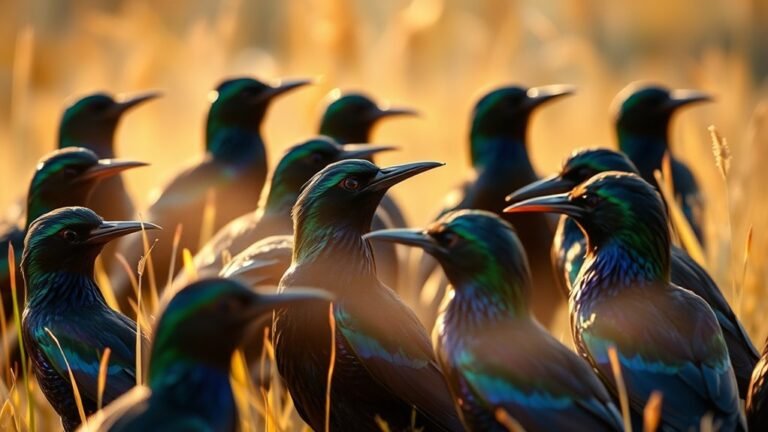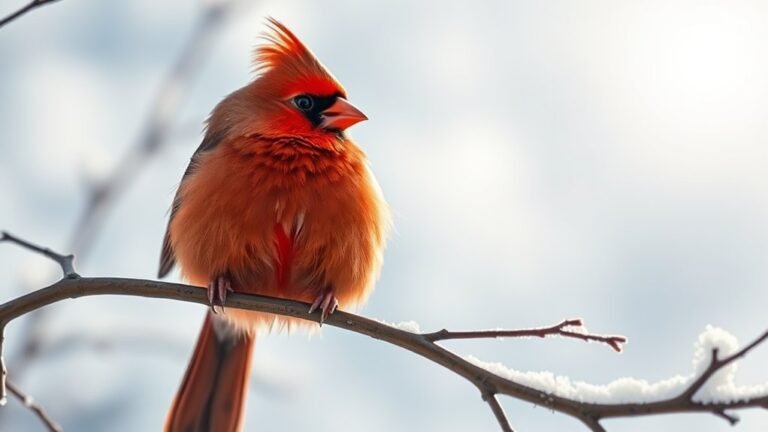North American Woodpeckers: Species, Habitats & Identification Tips
North America is home to a diverse array of woodpecker species, each with its unique characteristics and behaviors.
From the tiny Downy Woodpecker to the impressive Pileated Woodpecker, these birds play a crucial role in forest ecosystems and captivate birdwatchers across the continent.
In this comprehensive guide, we’ll explore the fascinating world of North American woodpeckers, their habitats, and how to identify them in the wild.
North American Woodpeckers at a Glance

- North America hosts at least 23 native woodpecker species, ranging from common backyard visitors to rare, endangered species.
- Woodpeckers are found in various habitats, including deciduous forests, coniferous forests, and even urban areas.
- The largest North American woodpecker is the Pileated Woodpecker, measuring up to 19 inches in length.
- Some woodpecker species, like the Yellow-bellied Sapsucker, are migratory, while others are year-round residents.
- Conservation efforts are crucial for protecting endangered woodpecker species, such as the Red-cockaded Woodpecker.
- Woodpeckers play a vital role in forest ecosystems by controlling insect populations and creating nesting cavities for other wildlife.
- Identifying woodpeckers involves observing their size, plumage patterns, behavior, and distinctive calls.
- Many woodpecker species are adaptable and can thrive in suburban and urban environments with suitable habitat.
- The Ivory-billed Woodpecker, once native to North America, is now considered extinct or critically endangered.
- Backyard bird feeders with suet and sunflower seeds can attract various woodpecker species for observation.
The Diverse World of North American Woodpeckers
North America boasts an impressive variety of woodpecker species, each adapted to specific habitats and ecological niches. Let’s explore some of the most notable woodpeckers found across the continent.
Downy Woodpecker: The Diminutive Drummer

The Downy Woodpecker is the smallest woodpecker in North America, measuring only 6 to 7 inches in length.
This charming bird is a common sight in backyards and forests throughout much of the United States and Canada.
Downy Woodpeckers have distinctive black and white plumage, with males sporting a small red patch on the back of their heads.
Pileated Woodpecker: The Forest Giant

At the other end of the size spectrum is the Pileated Woodpecker, North America’s largest woodpecker species.
These impressive birds can reach lengths of up to 19 inches and are easily recognized by their striking red crests and bold black and white plumage.
Pileated Woodpeckers inhabit mature forests across much of eastern North America and parts of the Pacific Northwest.
Red-headed Woodpecker: The Colorful Charmer

The Red-headed Woodpecker is one of the most visually striking species, with its bright red head, black back, and white underparts.
These woodpeckers are found in open woodlands and forest edges across eastern and central North America. Unfortunately, Red-headed Woodpecker populations have declined in recent years due to habitat loss.
Northern Flicker: The Ground-Feeding Woodpecker

Unlike many of its tree-dwelling relatives, the Northern Flicker spends much of its time foraging on the ground for ants and other insects.
These woodpeckers are found across North America and come in two distinct varieties: the Yellow-shafted Flicker in the east and the Red-shafted Flicker in the west.
The diversity of woodpecker species in North America reflects the continent’s varied landscapes and ecosystems.
From the arid Southwest to the boreal forests of Canada, woodpeckers have adapted to thrive in a wide range of habitats.
This adaptability has allowed them to become important components of many different ecological communities, contributing to biodiversity and forest health across the continent.
Woodpecker Habitats and Distribution

Woodpeckers have adapted to a wide range of habitats across North America, from dense forests to open woodlands and even urban areas. Understanding their preferred habitats can help birdwatchers locate and identify different species.
Forest Dwellers
Many woodpecker species, such as the Pileated Woodpecker and Hairy Woodpecker, are primarily associated with mature forests.
These birds require large trees for nesting and foraging, making them important indicators of forest health.
Suburban Adaptors
Some woodpeckers, like the Downy Woodpecker and Red-bellied Woodpecker, have successfully adapted to suburban environments. These species often visit backyard bird feeders and nest in both natural and artificial cavities.
Specialized Habitats
Certain woodpecker species have highly specific habitat requirements. For example, the endangered Red-cockaded Woodpecker is found exclusively in mature pine forests of the southeastern United States.
The distribution of woodpeckers across North America is influenced by factors such as forest type, climate, and food availability.
Some species, like the Downy Woodpecker, have a wide range that spans much of the continent, while others, such as the Gila Woodpecker, are limited to specific regions.
Understanding these distribution patterns can help birdwatchers predict where they might encounter different woodpecker species in their local areas.
Woodpecker Behavior and Ecology

Woodpeckers play a crucial role in forest ecosystems and exhibit fascinating behaviors that set them apart from other birds.
Drumming and Communication
Woodpeckers are well-known for their drumming behavior, which serves multiple purposes. In addition to foraging for insects, drumming is used for territorial defense and mate attraction. Each species has a unique drumming pattern that can aid in identification.
Nesting and Reproduction
Most woodpeckers excavate their own nesting cavities in dead or dying trees. These cavities provide essential shelter not only for woodpeckers but also for many other cavity-nesting species.
Woodpeckers typically lay 3-6 eggs and share incubation and chick-rearing duties between both parents.
Feeding Habits
Woodpeckers have diverse diets that include insects, tree sap, fruits, and nuts. Some species, like the Acorn Woodpecker, are known for their habit of storing food in specially created granaries.
The ecological impact of woodpeckers extends far beyond their role as insect predators. By creating nesting cavities, woodpeckers act as ecosystem engineers, providing homes for a wide range of other species, including owls, bats, and small mammals.
This makes woodpeckers keystone species in many forest ecosystems, with their presence supporting a diverse community of wildlife.
Conservation Challenges and Efforts

While many woodpecker species maintain healthy populations, others face significant conservation challenges.
Habitat Loss
The primary threat to woodpecker populations is habitat loss due to deforestation and urban development. Conservation efforts focus on preserving mature forests and creating suitable habitats in managed landscapes.
Endangered Species
The Red-cockaded Woodpecker is listed as endangered due to the loss of its specialized pine forest habitat. Intensive conservation efforts, including habitat management and artificial nest cavity creation, have helped stabilize some populations.
Climate Change Impacts
Climate change poses a growing threat to woodpecker species by altering forest composition and increasing the frequency of wildfires. Researchers are studying how these changes may impact woodpecker populations and distribution in the future.
Conservation efforts for woodpeckers often have far-reaching benefits for entire ecosystems. By protecting woodpecker habitats, conservationists help preserve biodiversity and maintain healthy forest ecosystems.
These efforts often involve collaboration between government agencies, conservation organizations, and private landowners to create comprehensive management plans that benefit woodpeckers and other wildlife species.
Identifying Woodpeckers in the Field

For birdwatchers and nature enthusiasts, identifying woodpeckers can be an exciting challenge. Here are some tips to help you recognize different species:
Size and Shape
Pay attention to the overall size and body shape of the woodpecker. Is it small like a Downy Woodpecker or large like a Pileated Woodpecker?
Plumage Patterns
Observe the distinctive markings and color patterns on the bird’s head, back, and wings. Look for features like red patches, striped backs, or spotted wings.
Behavior
Watch how the woodpecker moves and forages. Does it cling to tree trunks or spend time on the ground? Some species have unique behaviors that can aid in identification.
Calls and Drumming
Learn to recognize the vocalizations and drumming patterns of different woodpecker species. These auditory cues can be valuable for identification, especially when the bird is not visible.
Identifying woodpeckers in the field requires a combination of observation skills and knowledge. Birdwatchers often use field guides and mobile apps to assist with identification.
These tools provide detailed information on plumage patterns, range maps, and vocalizations, making it easier to distinguish between similar species.
With practice, birdwatchers can become adept at quickly identifying woodpeckers based on their unique characteristics and behaviors.
Attracting Woodpeckers to Your Backyard
Many woodpecker species readily visit backyard bird feeders, providing excellent opportunities for observation and photography.
Feeder Selection
Offer suet feeders and platform feeders with sunflower seeds to attract woodpeckers. Some species also enjoy peanuts and fruit.
Habitat Creation
Maintain dead or dying trees (if safe to do so) on your property to provide natural foraging and nesting sites for woodpeckers.
Water Sources
Provide a shallow birdbath or water feature to attract woodpeckers and other bird species to your yard.
Creating a woodpecker-friendly backyard can be a rewarding experience for nature enthusiasts. By providing the right combination of food, water, and habitat, you can attract a variety of woodpecker species to your property.
This not only offers opportunities for close observation but also contributes to local conservation efforts by supporting urban wildlife populations.
Remember to maintain feeders and water sources regularly to ensure the health and safety of visiting birds.
Frequently Asked Questions
What is the smallest woodpecker in North America?
The Downy Woodpecker is the smallest woodpecker species in North America, measuring only 6 to 7 inches in length.
Are any woodpecker species endangered?
Yes, the Red-cockaded Woodpecker is listed as endangered due to habitat loss. Other species, like the Ivory-billed Woodpecker, are considered extinct or critically endangered.
Do all woodpeckers migrate?
No, most woodpecker species are year-round residents in their habitats. However, the Yellow-bellied Sapsucker is notable for being the only migratory woodpecker in North America.
How can I tell the difference between a Downy and Hairy Woodpecker?
While similar in appearance, Hairy Woodpeckers are larger than Downy Woodpeckers and have longer bills relative to their head size. Hairy Woodpeckers also lack the black spots on their outer tail feathers that Downy Woodpeckers have.
What do woodpeckers eat?
Woodpeckers have diverse diets that include insects (especially wood-boring beetles and ants), tree sap, fruits, nuts, and seeds. Some species also visit bird feeders for suet and sunflower seeds.

Kashvi is a passionate bird enthusiast and nature lover who has been fascinated by the world of birds for years. With a keen eye for detail and a love for learning, Kashvi is dedicated to sharing her knowledge and insights with fellow bird enthusiasts on Avian Enthusiasts. Through her engaging and informative articles, Kashvi aims to inspire others to join her in exploring the fascinating world of birds and to promote a deeper appreciation for these incredible creatures.







